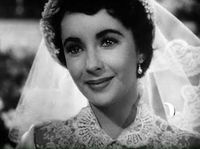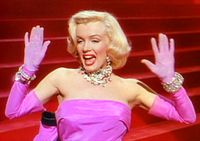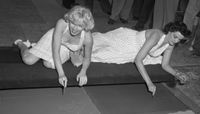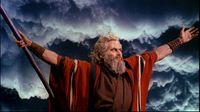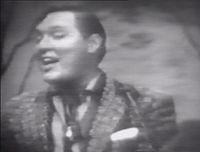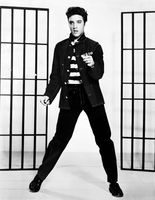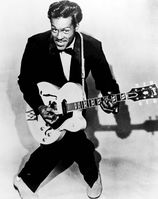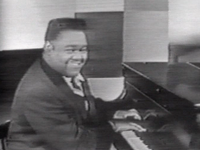عقد 1950

| الألفية: | الألفية 2 |
| القرون: | القرن 19 – القرن 20 – القرن 21 |
| العقود: | عقد 1920 عقد 1930 عقد 1940 – عقد 1950 – عقد 1960 عقد 1970 عقد 1980 |
| Years: | 1950 1951 1952 1953 1954 1955 1956 1957 1958 1959 |
| التصنيفات: | المواليد – الوفيات – العمارة التأسيسات – الانحلالات |
عقد 1950 أو الخمسينيات كانت عقداً بدأ في 1 يناير 1950 and ended on December 31, 1959. By its end, the world had largely recovered from World War II and the Cold War developed from its modest beginning in the late 1940s to a hot competition between the United States and the Soviet Union by the beginning of the 1960s.
Clashes between communism and capitalism dominated the decade, especially in the Northern Hemisphere. The conflicts included the الحرب الكورية في بداية العقد وبداية سباق الفضاء with the launch of Sputnik I. Along with increased testing of nuclear weapons (such as RDS-37 and Upshot-Knothole), this created a politically conservative climate. In the United States, the Red Scare (fear of communism) caused public Congressional hearings by both houses in Congress and anti-communism was the prevailing sentiment in the United States throughout the decade. بداية إزالة الاستعمار في أفريقيا وآسيا occurred in this decade and accelerated in the following decade, the 1960s.
الحروب والنزاعات
- الحرب الباردة conflicts involving the influence of the rival superpowers of the Soviet Union and the United States
- الحرب الكورية (1950–1953) – The war, which lasted from June 25, 1950 until the signing of the Korean Armistice Agreement on July 27, 1953, started as a civil war between North Korea and the Republic of Korea (South Korea). When it began, North and South Korea existed as provisional governments competing for control over the Korean peninsula, due to the division of Korea by outside powers. While originally a civil war, it quickly escalated into a war between the Western powers under the United Nations Command led by the United States and its allies and the communist powers of the People's Republic of China and the Soviet Union. On September 15, General Douglas MacArthur conducted Operation Chromite, an amphibious landing at the city of Inchon (Song Do port). The North Korean army collapsed, and within a few days, MacArthur's army retook Seoul (عاصمة كوريا الجنوبية). He then pushed north, capturing Pyongyang in October. Chinese intervention the following month drove UN forces south again. MacArthur then planned for a full-scale invasion of China, but this was against the wishes of President Truman and others who wanted a limited war. He was dismissed and replaced by General Matthew Ridgeway. The war then became a bloody stalemate for the next two and a half years while peace negotiations dragged on. The war left 33,742 American soldiers dead, 92,134 wounded, and 80,000 Missing in action (MIA) or Prisoner of war (POW). Estimates place Korean and Chinese casualties at 1,000,000–1,400,000 dead or wounded, and 140,000 MIA or POW.
- حرب ڤيتنام بدأت في 1959. Diem instituted a policy of death penalty against any communist activity in 1956. The Vietminh began an assassination campaign in early 1957. An article by French scholar Bernard Fall published in July 1958 concluded that a new war had begun. The first official large unit military action was on September 26, 1959, when the Vietcong ambushed two ARVN companies.[1]
- Arab–Israeli conflict (Early 20th century-present)
- العدوان الثلاثي (1956) – أزمة السويس was a war fought on Egyptian territory in 1956. Following the nationalisation of the Suez Canal in 1956 by جمال عبد الناصر, the United Kingdom, France and Israel subsequently invaded. The operation was a military success, but after the United States and Soviet Union united in opposition to the invasion, the invaders were forced to withdraw. This was seen as a major humiliation, especially for the two Western European countries, and symbolizes the beginning of the end of colonialism and the weakening of European global importance, specifically the collapse of the الامبراطورية البريطانية.
- Algerian War (1954–1962) – An important decolonization war, it was a complex conflict characterized by guerrilla warfare, maquis fighting, terrorism against civilians, use of torture on both sides and counter-terrorism operations by the French Army. The war eventually led to the independence of Algeria from France.
النزاعات الداخلية

- Cuban Revolution (1953–1959) – The 1959 overthrow of Fulgencio Batista by Fidel Castro, Che Guevara and other forces resulted in the creation of the first communist government in the Western hemisphere.
- The Mau Mau began retaliating against the British in Kenya. This led to concentration camps in Kenya, a British military victory, and the election of moderate nationalist Jomo Kenyatta as leader of Kenya.
- The wind of destruction began in Rwanda in 1959, following the beating up of Hutu politician Dominique Mbonyumutwa by Tutsi forces. This was the beginning of decades of ethnic violence in the country, which culminated in the 1994 Rwandan Genocide.
ازالة الاستعمار والاستقلال
- ازالة استعمار الامبراطوريات الاستعمارية الاوروبية السابقة. The الجمهورية الفرنسية الرابعة in particular faced conflict on two fronts within the French Union, the حرب الجزائر وحرب الهند الصينية الأولى. اتحاد الملايا peacefully gained independence from the المملكة المتحدة in 1957. French rule ended in Algeria in 1958, Vietnam left French Indo-china in 1954. The rival states of ڤيتنام الشمالية and South Vietnam were formed. Cambodia and the Kingdom of Laos also gained independence, effectively ending French presence in Southeast Asia. Elsewhere the Belgian Congo and other African nations gained their independence from France, Belgium and the United Kingdom.
- Large-scale decolonization in Africa first began in the 1950s. In 1951, Libya became the first African country to gain independence in the decade, and in 1954 the Algerian War began. 1956 saw Sudan, Morocco, and Tunisia become independent, and the next year Ghana became the first أفريقيا جنوب الصحراء nation to gain independence.
القضايا الدولية
- Establishment of the Non-aligned Movement, consisting of nations not formally aligned with or against any major power bloc.
Africa
- Africa experienced the beginning of large-scale top-down economic interventions in the 1950s that failed to cause improvement and led to charitable exhaustion by the West as the century went on. The widespread corruption was not dealt with and war, disease, and famine continued to be constant problems in the region.
- Egyptian general Gamel Abdel Nasser overthrew the Egyptian monarchy, establishing himself as President of Egypt. Nasser became an influential leader in the Middle East in the 1950s, leading Arab states into war with Israel, becoming a major leader of the Non-Aligned Movement and promoting pan-Arab unification.

الكوارث
Natural:
- On 15 August 1950 an earthquake and floods in Assam, India killed 574 and left 5,000,000 homeless.
- On 18 January 1951 Mount Lamington erupted in Papua New Guinea, killing 3,000 people.
- On 31 January 1953 the North Sea flood of 1953 killed 1,835 people in the southwestern Netherlands (especially Zeeland) and 307 in the United Kingdom[2]
- On 9 September 1954 an earthquake centered on the city of Orléansville, Algeria killed 1,500 and left thousands homeless.
الاقتصاد
- The الولايات المتحدة was the most influential economic power in the world after WWII under the presidency of Dwight D. Eisenhower.
العلوم والتكنولوجيا
التكنولوجيا
Television, which first reached the marketplace in the 1940s, attained maturity during the 50s and by the end of the decade, most American households owned a TV set. A rush to produce larger screens than the tiny ones found on 40s models occurred during 1950-52. In 1954, RCA introduced the CTC-1, the first color TV to utilize the NTSC video standard. It was expensive however, and black-and-white sets would remain the norm for the next decade. The Chevrolet Corvette becomes the first car to have an all-fiberglass body in 1953. In 1954 Bell Telephone Labs produced the first Solar battery. In 1954 you could get a yard of contact paper for only 59 cents. Polypropylene was invented in 1954. In 1955 Jonas Salk invented a polio vaccine which was given to more than seven million American students. In 1956 a solar powered wrist watch was invented. A surprise came in 1957; a 184-pound (83 kg) satellite named Sputnik 1 was launched by the Soviets. The space race began 4 months later as the United States launched a smaller satellite. In 1958 the first plastic Coke bottle appeared.

- Charles H. Townes builds the Maser in 1953 at the Columbia University.
- The Soviet Union launches Sputnik 1, the first artificial satellite to orbit the earth on October 4, 1957.
- The United States conducts its first hydrogen bomb explosion test.
- The invention of the modern Solar cell.
- Passenger jets enter service.
- The U.S uses Federal prisons, mental institutions and pharmalogical testing volunteers to test drugs like LSD and chlorpromazine. Also started experimenting with the transorbital lobotomy.
العلوم
- Francis Crick and James Watson discover the double-helix structure of DNA.
- An immunization vaccine is produced for polio.
- The first successful ultrasound test of the heart activity.
- The CERN is established.
- The world's first nuclear power plant is opened in Obninsk near Moscow.
- NASA is organized.
- President Harry S. Truman inaugurated transcontinental television service on September 4, 1951 when he made a speech to the nation. AT&T carried his address from San Francisco and it was viewed from the west coast to the east coast at the same time.
- The first human [cervical] cancer cells were cultured outside of a body in 1951, From Henrietta Lacks, the cells are known as the immortal cells
Popular culture
الموسيقى

الأفلام
Sports
Olympics
- 1952 Summer Olympics held in Helsinki, Finland
- 1952 Winter Olympics held in Oslo, Norway
- 1956 Summer Olympics held in Melbourne, Australia
- 1956 Winter Olympics held in Cortina d'Ampezzo, Italy
FIFA World Cups
- 1950 World Cup hosted by Brazil, won by Uruguay
- 1954 World Cup hosted by Switzerland, won by West Germany
- 1958 World Cup hosted by Sweden, won by Brazil
أشخاص
زعماء العالم
- إسكندر مرزا (پاكستان)
- أيوب خان (پاكستان)
- الأمين العام يوسف ستالين (الاتحاد السوڤيتي)
- الأمين العام نيكيتا خروشوڤ (الاتحاد السوڤيتي)
- رئيس الوزراء ونستون تشرشل (المملكة المتحدة)
- رئيس الوزراء Anthony Eden (المملكة المتحدة)
- رئيس الوزراء Harold Macmillan (المملكة المتحدة)
- الرئيس Juho Kusti Paasikivi (فنلندا)
- الرئيس Urho Kekkonen (فنلندا)
- الرئيس Laureano Gómez (كولومبيا)
- الرئيس Roberto Urdaneta Arbeláez (كولومبيا)
- الرئيس Gustavo Rojas Pinilla (كولومبيا)
- الرئيس Harry S. Truman (الولايات المتحدة)
- الرئيس Dwight D. Eisenhower (الولايات المتحدة)
- الرئيس Charles de Gaulle (فرنسا)
- الرئيس Vincent Auriol (فرنسا)
- الرئيس René Coty (فرنسا)
- الرئيس Miguel Alemán Valdés (المكسيك)
- الرئيس Adolfo Ruiz (المكسيك)
- الرئيس Adolfo López Mateos (المكسيك)
- رئيس الوزراء داڤيد بن گوريون (إسرائيل)
- الرئيس Arturo Frondizi (الأرجنتين)
- الرئيس Juan Perón (الأرجنتين)
- رئيس الوزراء Robert Menzies (Australia)
- الرئيس Getúlio Vargas (البرازيل)
- الرئيس Juscelino Kubitschek (البرازيل)
- رئيس الوزراء Louis St. Laurent (كندا)
- رئيس الوزراء John Diefenbaker (كندا)
- الرئيس Carlos Prío Socarrás (كوبا)
- الرئيس Fulgencio Batista (كوبا)
- الرئيس Anselmo Alliegro y Milá (كوبا) (interim)
- الرئيس Carlos Manuel Piedra (كوبا)
- الرئيس Manuel Urrutia Lleó (كوبا)
- الرئيس Osvaldo Dorticós Torrado (كوبا) - منذ 1959
- رئيس الوزراء Kim Il Sung (North Korea)
- Chairman Mao Zedong (People's Republic of China)
- الرئيس Chiang Kai-shek (جمهورية الصين في تايوان)
- الملك George VI (Commonwealth realms)
- Elizabeth II (Commonwealth realms)
- رئيس الوزراء Lester Pearson (كندا)
- الرئيس جمال عبد الناصر (مصر)
- الامبراطور Haile Selassie (إثيوپيا)
- الرئيس Juho Kusti Paasikivi (Finland)
- الرئيس Urho Kekkonen (Finland)
- رئيس الوزراء Jawaharlal Nehru (الهند)
- الرئيس سوكارنو (إندونيسيا)
- رئيس الوزراء محمد مصدق (إيران)
- الشاه Mohammad Reza Pahlavi (Iran)
- King Faisal II (Iraq)
- الرئيس محمد نجيب الرباعي (Iraq)
- Taoiseach John A. Costello (أيرلندا)
- Taoiseach Éamon de Valera (أيرلندا)
- Taoiseach Seán Lemass (أيرلندا)
- رئيس الوزراء Alcide De Gasperi (إيطاليا)
- الامبراطور هيروهيتو (اليابان)
- الرئيس Bolesław Bierut (Poland)
- الملك إدريس السنوسي (ليبيا) - من 1951
- رئيس الوزراء George Borg Olivier (مالطا)
- رئيس الوزراء António de Oliveira Salazar (البرتغال)
- Generalissimo Francisco Franco (اسبانيا)
- رئيس الوزراء Tage Erlander (السويد)
- الرئيس جلال بايار (تركيا)
- رئيس الوزراء عدنان منريس (تركيا)
- Pope Pius XII (Vatican)
- Pope John XXIII (Vatican)
- Chancellor Konrad Adenauer (West Germany)
- الرئيس Josip Broz Tito (Yugoslavia)
- Tunku Abdul Rahman (Malaya)
- Marcos Pérez Jiménez (Venezuela)
السياسة
- Aleksey Innokentevich Antonov, Chief of General Staff of the Unified Armed Forces Warsaw Treaty Organization
- يوجين بلاك، رئيس البنك الدولي
- William Sterling Cole, Director-general International Atomic Energy Agency
- Manuel Fraga Iribarne, Secretary-general Latin Union
- André François-Poncet, Chairman of the Standing Commission International Red Cross and Red Crescent Movement
- Louis Goffin, Secretary-general Western European Union
- Walter Hallstein, President of the European Commission
- Fritz Hess, Director Universal Postal Union
- Ivan Stepanovich Konev, Commander-in-chief of the Unified Armed Forces Warsaw Treaty Organization
- Henri St. Leger, Secretary-general International Organization for Standardization
- Robert C. Lonati, Secretary-general World Tourism Organization
- David A. Morse, Director-general International Labour Organization
- Arnold Duncan McNair, Baron McNair, President of the European Court of Human Rights
- Ove Nielsen, Secretary-general International Maritime Organization
- Maurice Pate, Executive Director United Nations Children's Fund
- Robert Schuman, President of the European Parliamentary Assembly
- Gustav Swoboda, Chief of the Secretariat World Meteorological Organization
- José Guillermo Trabanino Guerrero, Secretary-general Organization of Central American States
- Eric Wyndham White, Executive Secretary World Trade Organization
Entertainers
Elizabeth Taylor in Father of the Bride 1950
Marilyn Monroe performing "Diamonds Are a Girl's Best Friend" in Gentlemen Prefer Blondes 1953
Marilyn Monroe and Jane Russell putting signatures, hand and foot prints in cement at Grauman's Chinese Theater, 1953
Montgomery Clift in I Confess, 1953
Marlon Brando with Eva Marie Saint in the trailer for On the Waterfront 1954
Humphrey Bogart and Katharine Hepburn in The African Queen 1951
James Dean as Cal in East of Eden 1955
Charlton Heston in The Ten Commandments, 1956
- Steve Allen
- Desi Arnaz
- Fred Astaire
- Gene Autry
- Lauren Bacall
- Lucille Ball
- Brigitte Bardot
- Harry Belafonte
- Jean-Paul Belmondo
- Jack Benny
- Ingrid Bergman
- Humphrey Bogart
- Marlon Brando
- Lloyd Bridges
- Yul Brynner
- Richard Burton
- James Cagney
- Cab Calloway
- Johnny Carson
- Montgomery Clift
- Clay Cole
- Gary Cooper
- Joan Crawford
- Bing Crosby
- Tony Curtis
- Peter Cushing
- Dorothy Dandridge
- Bette Davis
- Doris Day
- James Dean
- Anne Francis
- Sandra Dee
- Brandon deWilde
- Marlene Dietrich
- Cliff Robertson
- Jon Provost
- Troy Donahue
- Diana Dors
- Kirk Douglas
- Clint Eastwood
- Henry Fonda
- Errol Flynn
- William Frawley
- Clark Gable
- Ava Gardner
- Judy Garland
- Cary Grant
- John Gregson
- Alec Guinness
- Tony Hancock
- Julie Harris
- Susan Hayward
- Rita Hayworth
- Audrey Hepburn
- Katharine Hepburn
- Charlton Heston
- William Holden
- Judy Holliday
- Bob Hope
- Rock Hudson
- Van Johnson
- Jessica Jones
- Gene Kelly
- Grace Kelly
- Deborah Kerr
- Alan Ladd
- Burt Lancaster
- Janet Leigh
- Jack Lemmon
- Jerry Lewis
- Sophia Loren
- Shirley MacLaine
- Jayne Mansfield
- Dean Martin
- Giulietta Masina
- James Mason
- Marcello Mastroianni
- Jerry Mathers
- Toshiro Mifune
- Sal Mineo
- Ray Milland
- Hayley Mills
- Robert Mitchum
- Marilyn Monroe
- Yves Montand
- Ricky Nelson
- Paul Newman
- Kim Novak
- Laurence Olivier
- Jack Palance
- Geraldine Page
- Gregory Peck
- Anthony Quinn
- George Reeves
- Steve Reeves
- Tommy Rettig
- Debbie Reynolds
- Thelma Ritter
- Roy Rogers
- Cesar Romero
- Jane Russell
- Rosalind Russell
- Eva Marie Saint
- Frank Sinatra
- Kim Stanley
- Barbara Stanwyck
- James Stewart
- Max von Sydow
- Elizabeth Taylor
- Robert Taylor
- Lana Turner
- Spencer Tracy
- Vivian Vance
- Robert Wagner
- John Wayne
- Richard Widmark
- Shelley Winters
- Jack Webb
- Orson Welles
Musicians
Bill Haley of Bill Haley and the Comets singing Rock Around the Clock, 1955
Elvis Presley in a publicity photo for Jailhouse Rock (1957)
Chuck Berry in 1957
Fats Domino singing Blueberry Hill on The Alan Freed Show c. 1956
- Marian Anderson
- Paul Anka
- Louis Armstrong
- Harry Belafonte
- Tony Bennett
- Chuck Berry
- The Big Bopper
- Pat Boone
- Teresa Brewer
- Roy Brown
- Dave Brubeck
- Sam Butera
- Maria Callas
- Johnny Cash
- Ray Charles
- Lou Christie
- June Christy
- Rosemary Clooney
- Eddie Cochran
- Nat "King" Cole
- John Coltrane
- Perry Como
- Pee Wee Crayton
- Bing Crosby
- Gary Crosby
- داليدا
- Bobby Darin
- Miles Davis
- Bobby Day
- Doris Day
- Bo Diddley
- Willie Dixon
- Carl Dobkins, Jr.
- Fats Domino
- Eddie Fisher
- Ella Fitzgerald
- Connie Francis
- Mary Ford
- Tennessee Ernie Ford
- Billy Fury
- Georgia Gibbs
- Dizzy Gillespie
- Arthur Godfrey
- Benny Goodman
- Gogi Grant
- Jack Guthrie
- Homer Harris
- Wynonie Harris
- Roy Hamilton
- Lionel Hampton
- Al Hibbler
- Earl Hines
- Billie Holliday
- Buddy Holly
- John Lee Hooker
- Johnny Horton
- Bull Moose Jackson
- Mahalia Jackson
- Elmore James
- Etta James
- Joni James
- Sonny James
- Waylon Jennings
- Jimmy Jones
- Louis Jordan
- Kitty Kallen
- Chris Kenner
- B.B. King
- Ben E. King
- Saunders King
- Gene Krupa
- Frankie Laine
- Mario Lanza
- Brenda Lee
- Peggy Lee
- Jerry Lee Lewis
- Little Willie Littlefield
- Julie London
- Dean Martin
- Johnny Mathis
- Skeets McDonald
- Amos Milburn
- Chuck Miller
- Mitch Miller
- Guy Mitchell
- Charles Mingus
- Thelonious Monk
- Vaughn Monroe
- Rose Murphy
- Jimmy Nelson
- Ricky Nelson
- Donald O'Conner
- Odetta
- Gene O'Quin
- Roy Orbison
- Johnny Otis
- Patti Page
- Charlie Parker
- Les Paul
- Art Pepper
- Carl Perkins
- Elvis Presley
- Johnny Preston
- Jimmy Preston
- Louis Prima
- Johnnie Ray
- Jerry Reed
- Django Reinhardt
- Buddy Rich
- Little Richard
- Max Roach
- Marty Robbins
- Jimmie Rodgers
- Neil Sedaka
- Pete Seeger
- Dinah Shore
- Frank Sinatra
- Kay Starr
- Joan Sutherland
- Art Tatum
- Big Mama Thornton
- Johnny Tillotson
- Merle Travis
- Big Joe Turner
- Ritchie Valens
- Gene Vincent
- T-Bone Walker
- Mercy Dee Walton
- Muddy Waters
- Josh White
- Andy Williams
- Hank Williams
- Otis Williams
- Howlin' Wolf
Bands
- The Ames Brothers
- The Andrews Sisters
- Little Anthony and the Imperials
- Dave Appell & the Applejacks
- The Cadillacs
- The Capris
- The Coasters
- The Champs
- Otis Williams and the Charms
- The Chimes
- The Chips
- The Chordettes
- The Chords
- The Clovers
- The Collegians
- The Counts
- The Crew Cuts
- The Crows
- Danny & the Juniors
- Jan & Dean
- The Dells
- The Del-Satins
- Del-Vikings
- Deep River Boys
- The Dubs
- The Duprees
- The Diamonds
- Dion & The Belmonts
- The Drifters
- The Echoes
- The El Dorados
- The Elegants
- The Emotions
- The Everly Brothers
- The Falcons
- The Flamingos
- The Flairs
- The Fleetwoods
- The Five Discs
- The Five Keys
- The Five Sharps
- The Fontane Sisters
- The Four Aces
- The Four Freshmen
- The Four Lads
- The Four Lovers
- The Four Preps
- The Four Tunes
- The G-Clefs
- Bill Haley and the Comets
- The Harptones
- The Heathertones
- The Hilltoppers
- The Hollywood Flames
- The Impalas
- The Ink Spots
- The Kingston Trio
- The Larks
- Frankie Lymon & The Teenagers
- The McGuire Sisters
- The Mello-Kings
- The Mills Brothers
- The Monotones
- The Moonglows
- The Mystics
- The Orioles
- The Platters
- The Quarrymen
- The Quotations
- The Ravens
- The Regents
- The Robins
- The Spaniels
- Sparkletone
- The Stereos
- The Swallows
- Mickey & Sylvia
- Tátrai Quartet
- The Virtues
- Billy Ward & The Dominoes
- The Wrens
- Maurice Williams and the Zodiacs
- Windsbacher Knabenchor
Timeline
The following articles contain brief timelines which list the most prominent events of the decade:
1950 • 1951 • 1952 • 1953 • 1954 • 1955 • 1956 • 1957 • 1958 • 1959
الهامش
- ^ The Pentagon Papers, Volume 1, Chapter 5, Section 3, "Origins of the Insurgency in South Vietnam, 1954-1960"
- ^ Stratton, J.M. (1969). Agricultural Records. John Baker. ISBN 978-0-212-97022-3.
للاستزادة
- Bessel, Richard and Dirk Schumann, eds. Life after Death: Approaches to a Cultural and Social History of Europe During the 1940s and 1950s (2003), essays by scholars on recovery from the war
- Judt, Tony. Postwar: A History of Europe Since 1945 (2005)
- London Institute of World Affairs, The Year Book of World Affairs 1957 (London 1957) full text online, comprehensive reference book covering 1956 in diplomacy, international affairs and politics for major nations and regions





